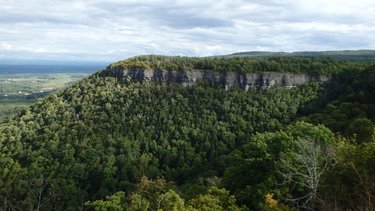NPS: The cliff face at Thacher Park shows 63M years of Earth’s history
ALBANY COUNTY — On Dec. 11, Secretary of the Interior Deb Haaland designated John Boyd Thacher Park as a National Natural Landmark.
At the same time, caverns in Colorado were also designated, bringing the total nationwide to 604.
Thacher joins 28 other National Natural Landmark sites in New York state, including two others in Albany County: The Albany Pine Bush Preserve and the Bear Swamp Preserve in Westerlo.
The national program was set up in 1962 to select areas that are the best examples of a biological community or geological feature based on condition, character, rarity, diversity, and scientific and educational value.
The Thacher designation was sought for three decades by New Scotland resident Tim Albright. (See related editorial.)
The park has been added to since Emma Treadwell Thacher, widow of Albany mayor and state senator John Boyd Thacher, donated 350 acres to the state in 1914.
The park’s roughly 2,000 acres is part of the Helderberg Conservation Corridor being assembled by the Mohawk Hudson Land Conservancy, which is highly rated in the state’s open-space plan and also prioritized by The Nature Conservancy.
The recent landmark designation, though, is not about species diversity or climate resiliency but rather focuses on geology.
“The site’s dominant landform is the Helderberg Escarpment,” says the National Park Service. “This ridge is a striking example of a cuesta; a type of asymmetrical hill with one gradually sloping side and one steeply sloping side or escarpment, forming a distinctively shaped ridge.”
The cuesta at Thacher was formed when what is now New York state was flooded by shallow seas. Sediments were deposited then and later the cliff face was eroded by the Hudson and Mohawk rivers.
The face of the cliff at Thacher park shows distinctive layered rock illustrating 14 different formations covering 63 million years, from the Late Ordovician, which was 450 million years ago, to the Middle Devonian, 388 million years ago, the Park Service says.
“The most interesting section at John Boyd Thacher State Park are the layers in the cliff face that date to the Silurian and Devonian periods,” it says, which are collectively referred to as the Middle Paleozoic Era, from 444 to 359 million years ago, a time in the Earth’s history characterized by high sea levels with expansion of marine invertebrates, reef communities, and fish.
“This era also marks the emergence of plants and insects on land, and near the end of the Devonian Period, the appearance of four-legged animals,” the Park Service says. “This geologic interval is critical to understand because the Appalachian Mountains and their surroundings, in fact most of eastern North America, is largely composed of rocks of this age.”
Marine fossils and sedimentary features have been found at Thacher Park that show what life on Earth was like millions of years ago.
Fossils from the Late Silurian period 425 million years ago of mud cracks, reef-building sponges, and layered mounds built by bacteria, known as bacterial thrombolite, suggest life in a highly saline, near-shore tidal environment.
A collection of abundant but low-diversity fossils from six million years later in the early Devonian period indicate a deepening of the shallow marine environment.
“The depositional record at John Boyd Thacher State Park is unparalleled in its completeness and provides a critical foundation to understanding the Middle Paleozoic Era in North America,” the National Park Service says. “These millions of years of geologic history are set within beautiful northern hardwoods of the Eastern Deciduous Forest, some of which have not been logged for at least 100 years.
“The geology gave rise to the great diversity of conditions and environments that comprise this rich forest ecosystem with 21 distinct ecological communities, many of which host rare plant and animal species. The park also contains 40 caves, 17 springs and excellent examples of clint and grike limestone pavement.”
“Clints” are flat limestone areas and “grikes” are the open cracks or fissures that isolate the individual clints. Together, these natural formations look like cracked pavement, or in the case of Thacher Park where the grikes are up to two feet wide and many tens of feet long, they look like natural gutters or canals.
The National Park service concludes that the Natural Landmark designations provide “an amazing opportunity to learn about and celebrate the great diversity of the Nation’s natural heritage.”
A Dec. 14 press release announcing the designation from New York State Parks, Recreation and Historic Preservation said, “Enthusiasts eager to delve into Thacher Park’s rich geological history are encouraged to visit. The park, open year-round, boasts a visitor center with educational exhibits, a nature center offering programs for children, and over 25 miles of trails, including the renowned Indian Ladder Trail along the cliff face and past picturesque waterfalls.”



